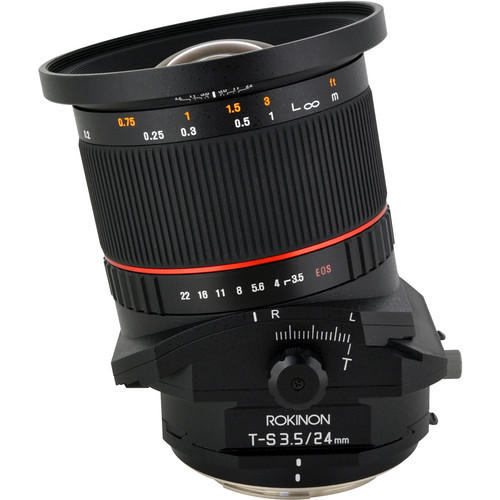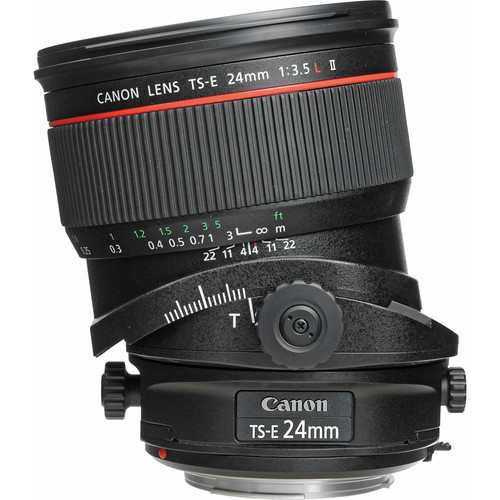I’ve been hearing good things about the image quality of Rokinon lenses lately, so I thought I’d give one a try using tilt-shift lenses (defined) since those are so expensive from Canon that they are cost prohibitive to most of my readers (myself included). Would the Rokinon equivalent lens really be in the same league when it cost $1000 USD less (at the time of this writing with Canon rebate)?

Rokinon Tilt-Shift 24mm f/3.5 ED AS UMC Lens for Canon ($999 USD)

Canon TS-E 24mm f/3.5L II Tilt-Shift Manual Focus Lens ($2,199 USD)
Using a Tilt Shift as a Regular Lens
These are two really sharp and nice lenses. While the tilt and shift features will prove handy, you can also really enjoy them as just a regular 24mm lens. Both offered super sharp results with no adjustments at all:

Canon EOS 5D Mark III, f/8 w/ Canon TS-E 24 mm, 3.2s, ISO 100, No Flash

Canon EOS 5D Mark III, f/8 w/ Rokinon TS-24mm, 3.2s, ISO 100, No Flash
It was raining when these shots were taken and I was holding an umbrella to protect the lenses, so I didn’t bother to do a shift to correct the perspective. This is pretty much how these quick snapshots came out of the camera with the only variable was the lens swap. The difference in framing was probably due to me bumping the tripod a bit, but both seemed to perform great in my opinion.
Using a Tilt Shift for Perspective Control
Here’s a tough real world environment where distortion reigns supreme:

Canon EOS 5D Mark III, f/10 w/ Canon TS-E 24 mm, 1/25, ISO 100, No Flash
By doing a simple upward shift and re-composing the camera I can correct the distortion of the trees that are currently leaning inward:

Foreground corrected with an upward shift and recompose (Canon)
Now my trees look better. The building in the background is still off a bit due to my angle which is one of the challenges of being at this level. I can correct the trees or the building, but not both unless I get myself higher up where everything is level on the same plane (instead of the angle that I am now).
Here’s another example of that challenge as I take a shot of multiple objects that are on a slope (and the art object is actually not straight in real life which creates more challenges):

Canon EOS 5D Mark III, f/10 w/ Rokinon 24mm, 1/8, ISO 100, No Flash
We are used to looking at images like this so at first things seem okay. If we shift and recompose we can fix the tree on the left to make it nice and straight as shown here:

Left tree corrected, but art object is now worse

Art object corrected, but trees are worse than the original
To avoid these types of problems you should stay on the same plane as your subject when making your correction, and try to have all of your subjects on the same plane a well (if possible). See the bookshelf example below for a demo where one adjustment fixes all the problems.
Physical Differences
Physically you can tell where the money difference goes, but surprisingly the Rokinon didn’t feel like a cheap lens. It has more substance and quality feel than a typical Canon EF-S lens, but the devil is in the details. The Rokinon may have a red ring, but it’s no pro lens by any stretch of the imagination!

The Rokinon (right) lacks contact points, so the aperture must be set
on the lens instead of through the camera
I hated the controls on the Rokinon quite a bit because they were tiny, hard to grip, very cheap feeling, and overly tight to rotate – yet the lens slipped out of position easier. It also drove me insane that it lacks a red dot on the top of the lens (instead it’s on the silver edge of the mount). This made it very difficult to get this lens on at night without a flashlight.

The Rokion (right) has a slightly larger lens bulge which made it more prone to lens flare,
and it doesn't come with a lens hood like the Canon

Canon (left) has an advantage of bigger knobs that lock down better

The cheapo gray knobs on the Rokinon (right) sucked - a lot - in real world use
Some will like that the Rokinon had a pinch lens cap like Nikon (and now Canon offers on some newer lenses).
Bookshelf Test
For my first test, with the camera placed on the tripod and doing a typical bookshelf shot like readers of this blog are used to seeing, I then did the following adjustments (in clockwise order starting with the top left image):
- Full shift up – no re-focus
- Full shift left – no re-focus
- Full shift right – no re-focus
- Full shift down – no re-focus
The objective of this test was to just compare how the light, bokeh, and focus were impacted by the shifts. To eliminate variables, all images were shot at f/8 @24 mm, 25s, ISO 100, and No Flash using a Canon 5D Mark III. The results are impossible to interpret unless you zoom to 100%, but here’s a single 12000x8000 pixel file for both lenses to help speed up the comparison. Individual files are also available at http://photos.ronmartblog.com/lenses/24mmtiltshiftcompare.

Canon Tilts & Shifts - Click and view at 100%

Rokinon Tilts & Shifts - Click and view at 100%

100% Comparison - NO SHIFT, Canon (left) & Rokinon (right)
Click for a larger image
For fun I decided to take a shot with my Canon 24-70 f/2.8L II lens and then swap lenses using the same exact position for a no-shift comparison of these lenses against each others and a benchmark lens. You can see a 100% crop above, and here’s a link to the Canon TS-E 24mm image and the Rokinon TS 24mm image for additional review.
What I found was that the Canon was slightly brighter and better at the edges over the Rokinon, but otherwise they were both excellent lenses that compared favorably to the non-tilt shift lens.
Practical Shift Test
I don’t care much about the tilt feature of a tilt shift lens, but I do like it for shifting to perform perspective control. To limit the variables, I once again used the same bookshelf setup and camera settings to simulate a scenario that required shifting the lens to correct distortion.

Canon (shown with hood) - Practical Shift Test
Click to view at 100%

Rokinon - Practical Shift Test
Click to view at 100%
I had a minor angle error in my Rokinon shot, but it didn’t impact my conclusion. Both lenses did a great job after making an upward shift, a camera angle adjustment to re-compose, and a re-focus.
Conclusion
My overall conclusion was that you have to look pretty hard to see the differences, so the Rokinon impressed me quite a bit. Really all that I could fault the Rokinon for was a seemingly inferior bokeh and the fact that it was a little darker. Sure, the Rokinon controls are garbage but they work so if you are gentle on your gear it should probably be fine. Image quality wise I’d call it “as good as” Canon, so there’s a lot you can do with that extra $1000 (like pick up other Rokinon lenses). Personally, I’ll just rent from
Tilt-shift lenses aren’t for everyone since they can be very tricky to use. Manual focus will be bothersome to some, but the real gotcha is the recompose requirement and exposure challenges once a tilt or shift has occurred. This is a pro users lens for sure, but it can be super rewarding too if you spend some time with it. It’s also a must for architecture because as good as the tilt shift correction is in Lightroom (especially 5) and Photoshop, you get more depth of field out of doing it in camera than you do when you correct the perspective in post-processing.
Where to order
Click here to order the Rokinon Tilt-Shift 24mm f/3.5 ED AS UMC Lens for Canon from the B&H web site.
Click here to order the Canon TS-E 24mm f/3.5L II Tilt-Shift Manual Focus Lens from the B&H web site. The current $200 OFF rebate ends on June 6th, 2013 at 8:59 PM Pacific, so act fast if you want this lens.
Where to rent
For expense, low-frequency usage gear it makes more sense to rent than buy for most people. That’s why I recommend LensRentals.com and BorrowLenses.com for your renting needs. See my discount coupon code page for a special discount when renting gear as well!


Not familiar with or worried about renting online? Check out my lens rental series where I show you what to expect and how it compares to renting from a local shop.
Other articles you may enjoy
If you enjoyed this article, you may also enjoy these reviews:
Disclosure
If you make a purchase using links found in this article, I may make a commission. It doesn’t cost you a penny more, but it does help to support future articles like this.
B&H loaned me the lenses used in this article for this review.
NOTE: This site requires cookies and uses affiliate linking to sites that use cookies.
. Either way, your support is greatly appreciated!
This blog is intended for freelance writing and sharing of opinions and is not a representative of any of the companies whose links are provided on this site.
The opinions provided are of Ron Martinsen alone and do not reflect the view of any other entity






























